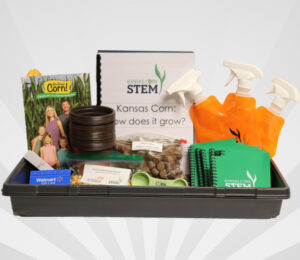Free Classroom Kit
How Does It Grow?
Grade Level: 2nd Grade
 Students work like scientists to test their ideas about what plants need to grow and live by using corn plants as model organisms. Students test growing conditions, such as amounts of water and sunlight. Consider whether you want to have students grow corn from seeds, or if you want to have seedlings already sprouted. If you choose the latter, you will need to plant and grow the corn about 2 weeks in advance.
Students work like scientists to test their ideas about what plants need to grow and live by using corn plants as model organisms. Students test growing conditions, such as amounts of water and sunlight. Consider whether you want to have students grow corn from seeds, or if you want to have seedlings already sprouted. If you choose the latter, you will need to plant and grow the corn about 2 weeks in advance.
Quick Links
About Kansas Corn STEM
Investing in Kansas teachers and students is a priority for the Kansas Corn Commission. We are committed to providing materials and training to support STEM education while fostering an understanding of how corn farming and agriculture fit into our daily lives. All K-5 lessons come with a free teacher kit that includes the teaching materials needed for each lesson.
Request MaterialsThis lesson is the work product of the Kansas Corn Commission. Our lessons are written in collaboration with Kansas teachers for use in the classroom. Teachers may copy and share this curriculum. Use of this product for commercial or promotional use is prohibited without express permission of Kansas Corn.
Newsletter Sign Up
Each quarter we release a newsletter written by teachers for teachers. This is an easy way to keep up with what is happening at Kansas Corn STEM.
Subscribe Today!